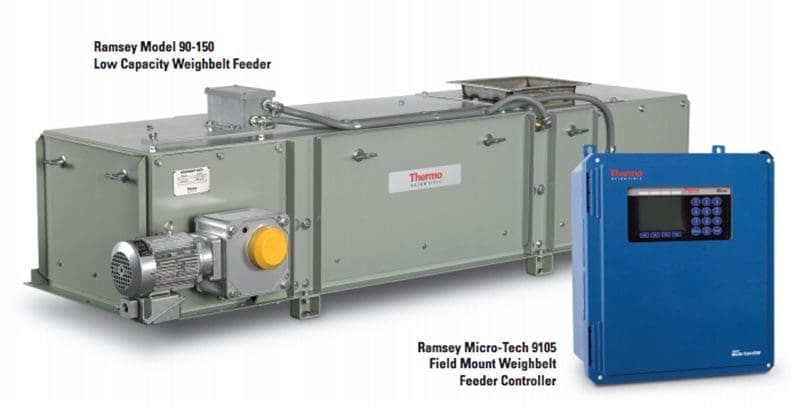Choosing between a volumetric or gravimetric weigh belt feeder means considering factors like:
- Industry application.
- Data accuracy
- Equipment purchase and maintenance budget.
- Material mass and density.
- The setup of the wider production system.
Both weigh solutions offer advanced measurement ability and can be integrated into any production system. Picking between gravimetric and volumetric feeders depends on your business' unique needs, with custom designed solutions usually the best option.
The three differences between volumetric and gravimetric feeders
1) Open versus closed loop operation
Volumetric weigh belt feeders are open-loop, set-speed devices, meaning they are dependent on a constant infeed of materials at a regular volume and density to work. This equipment is called open loop because there is no information being communicated between the feeder output and drive control system.
Gravimetric weigh belt feeders, meanwhile, are closed loop devices that continuously weigh material passing over the belt, and communicate this data back to the controller. This means speed corrections are made automatically to the setpoint rate. The most common forms of gravimetric system include belt, screw and vibratory.

2) Accuracy requirements
Volumetric weigh belt feeders require uniform and consistent material supply for feed accuracies within the one to five per cent range. Unreliable material feed will result in proportionate measurement inaccuracy. Gravimetric weigh belt feeders, on the other hand, can provide accuracy to around one per cent, thanks to its ability to check and recheck material density and mass passing the belt.
3) Servicing and operation costs
The gulf in complexity between the two systems means the skills and instruments required to service belt feeders differ greatly.
Volumetric solutions are simpler in operation, and therefore requires less engineering specialisation, and lower maintenance times and costs, to keep running to perfection. Gravimetric devices, however, are a lot more complex, so cost more to design and purchase, and will also require longer periods of downtime when servicing is required.
Determining relevant factors within your production system
Accounting for the differences between the two feeder systems, you still then need to think about how these devices will benefit your wider production system and application.
For example, plasterboard producers need to add a precise amount of gypsum to each mold during production. That means the ongoing weighing and self-checking of a gravimetric weigh belt solution feeder is a better fit in this case. Alternatively, a coal handling operation may just require a constant flow of coal to be cleaned, meaning a volumetric weigh belt feeder works better for this application.
Operators also need to consider the difference in time and cost when choosing the weight belt feeder solution to integrate into a wider production system. More complex and sensitive technology will naturally take longer to set up, which could affect relevant project timelines and budgets.

SRO Technology's weigh belt feeders
The versatility of weigh conveyor applications means SRO Technology doesn't offer a one-size-fits-all feeder. We have found, after more than 30 years' experience supporting industrial businesses, that a custom designed solution trumps anything off-the-shelf.
Our experts will come to your business site, analyse your key processes and create a tailored weigh belt feeder to satisfy your unique requirements. That means you gain a solution entirely fitted to your production system. Our gravimetric and volumetric weigh belt feeders are manufactured to withstand the harshest environments, minimising equipment maintenance and servicing time and expense in the long term. Our commitment to your operations also means we design our systems for optimised belt changing, cleaning of interiors and all other necessary upkeep, minimising downtime.
To learn whether a volumetric or gravimetric weigh belt feeder better suits your production system, contact the expert SRO Technology team today by clicking below.



Recent Comments